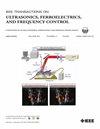Fusing Echocardiography Images and Medical Records for Continuous Patient Stratification
IF 3.7
2区 工程技术
Q1 ACOUSTICS
IEEE transactions on ultrasonics, ferroelectrics, and frequency control
Pub Date : 2025-08-20
DOI:10.1109/TUFFC.2025.3600902
引用次数: 0
Abstract
Deep learning enables automatic and robust extraction of cardiac function descriptors from echocardiographic sequences, such as ejection fraction (EF) or strain. These descriptors provide fine-grained information that physicians consider, in conjunction with more global variables from the clinical record, to assess patients’ condition. Drawing on novel Transformer models applied to tabular data, we propose a method that considers all descriptors extracted from medical records and echocardiograms to learn the representation of a cardiovascular pathology with a difficult-to-characterize continuum, namely hypertension. Our method first projects each variable into its own representation space using modality-specific approaches. These standardized representations of multimodal data are then fed to a Transformer encoder, which learns to merge them into a comprehensive representation of the patient through the task of predicting a clinical rating. This stratification task is formulated as an ordinal classification to enforce a pathological continuum in the representation space. We observe the major trends along this continuum on a cohort of 239 hypertensive patients, providing unprecedented details in the description of hypertension’s impact on various cardiac function descriptors. Our analysis shows that: 1) the XTab foundation model’s architecture allows to reach high performance (96.8% AUROC) even with limited data (less than 200 training samples); 2) stratification across the population is reproducible between trainings [within 5.7% of mean absolute error (MAE)]; and 3) patterns emerge in descriptors, some of which align with established physiological knowledge about hypertension, while others could pave the way for a more comprehensive understanding of this pathology. The code is available at融合超声心动图图像和医疗记录用于连续患者分层。
深度学习能够从超声心动图序列中自动和稳健地提取心功能描述符,如射血分数或应变。这些描述符提供了细粒度的信息,医生可以结合临床记录中的更多全局变量来评估患者的病情。利用应用于表格数据的新颖Transformer模型,我们提出了一种方法,该方法考虑了从医疗记录和超声心动图中提取的所有描述符,以学习具有难以表征的连续体(即高血压)的心血管病理的表示。我们的方法首先使用特定于模态的方法将每个变量投影到它自己的表示空间中。然后将这些多模态数据的标准化表示馈送到Transformer编码器,该编码器通过预测临床评级的任务学习将它们合并为患者的综合表示。这个分层任务被制定为一个有序的分类,以加强表征空间中的病理连续体。我们在239名高血压患者的队列中观察了这一连续体的主要趋势,在描述高血压对各种心功能描述符的影响方面提供了前所未有的细节。我们的分析表明,1)即使在有限的数据(少于200个训练样本)下,XTab基础模型的架构也可以达到高性能(96.8% AUROC), 2)在训练之间的人群分层是可重复的(在平均绝对误差的5.7%以内),3)描述符中出现的模式,其中一些与已建立的关于高血压的生理知识一致,而另一些则可以为更全面地理解这种病理铺平道路。代码可在。
本文章由计算机程序翻译,如有差异,请以英文原文为准。
求助全文
约1分钟内获得全文
求助全文
来源期刊
CiteScore
7.70
自引率
16.70%
发文量
583
审稿时长
4.5 months
期刊介绍:
IEEE Transactions on Ultrasonics, Ferroelectrics and Frequency Control includes the theory, technology, materials, and applications relating to: (1) the generation, transmission, and detection of ultrasonic waves and related phenomena; (2) medical ultrasound, including hyperthermia, bioeffects, tissue characterization and imaging; (3) ferroelectric, piezoelectric, and piezomagnetic materials, including crystals, polycrystalline solids, films, polymers, and composites; (4) frequency control, timing and time distribution, including crystal oscillators and other means of classical frequency control, and atomic, molecular and laser frequency control standards. Areas of interest range from fundamental studies to the design and/or applications of devices and systems.

 求助内容:
求助内容: 应助结果提醒方式:
应助结果提醒方式:


